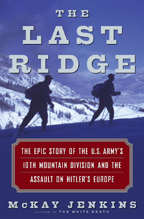|
Web Exclusives: Alumni Spotlight
March 10, 2004: The
Last Ridge A colorful collection of ski bums, European pseudo-mercenaries, and die-hard naturalists won a daring battle in Italy in 1945. But their exploits after World War II were so impressive — several founded ski resorts, others became leaders in the conservation movement — that history is starting to forget they were ever soldiers. In The Last Ridge: The Epic Story of the U.S. Army's 10th Mountain Division and the Assault on Hitler's Europe, published by Random House last fall, McKay Jenkins *96 chronicles an elite unit specializing in winter and high-altitude combat. While explaining the circumstances behind the Ski Troops' improbable founding, Jenkins profiles the soldiers and their never-ending training in the Appalachians and the Rockies. Then he takes readers to war-torn Europe and, eventually, the bloody assault on Riva Ridge.
A die-hard outdoorsman who tries to escape into the wilderness every weekend with wife Katherine Hickley '95, Jenkins also penned The White Death (2000), about five young men who died in an avalanche in Glacier National Park in 1969. An English professor at the University of Delaware, he wrote his latest book to relate the combat heroism of men he admired first for their green feats. "I always knew about the Ski Troops because many played key roles in the environmental movement," says Jenkins, who spent two years reading correspondence and interviewing veterans. "These guys are legends out West. But nobody knows what they did during the war." Like Band of Brothers, another World War II book-movie, The Last Ridge describes the grim realities of battle in great detail. Idealistic boys become men the hard way, and 4,000 of them die. Though aspects of the story have been told many times, Jenkins, who describes Princeton's William Howarth and John McPhee '53, as his "great mentors," definitely adds a novel twist to the tale with his meticulous, scholarly emphasis on the environment — love of it attracts civilians to become Ski Troopers; knowledge of it makes them excel at war. Like the unit, the book starts with Charles Minot Dole, a preppie New England skier who, as a civilian, helped convince Army brass that a specialized Alpine division was imperative for the European campaign, where battles were being waged as much against the elements and topography as hostile enemies. His argument was enhanced when a tiny band of Finnish mountain men brought an invading Soviet army to its knees in the winter of 1939-40 almost entirely because of their nature skills. Soon after the first roll call, trainees set military standards for soldiering and mountaineering during boot camp. Then it was time to halt Hitler, and the Ski Troops headed to Italy's Apennine Mountains, where, in the frigid months of 1945, they climbed 1,500 feet in darkness to help undue the Nazi linchpin on the Western Front. Adding to the lore, the victors fought without mountain gear, as a quartermaster had mistakenly left everything in stateside warehouses. The legend grew after the war, while staying outside, of course. Veterans competed in various Winter Olympics and founded over 60 ski resorts, including Aspen and Vail. Paul Petzoldt started the National Outdoor Leadership School, and David Brower headed The Sierra Club. A Jenkins favorite, world-famous hiker Bob Bates, ran the first Peace Corps office in Nepal. Oh, and then there was Bob Dole, a Kansas Republican whose combat injury forced him to enter politics instead of becoming a doctor as he had planned. By Rob MacKay '89 Rob McKay is an editor for Times Newsweekly in Queens, New York.
Home Current
Issue
Web Exclusives: Headlines - PawPlus - Features Tooke's Take - Varsity Typewriter - Inky Dinky Do Raising Kate - On the Campus - Comparative Life - More... PAW Online Archives - Print Archives - Advertising Info - Reader Services Search the Site - Contact PAW Princeton University - Alumni Links - Alumni Council - Your Class Secretary |
|||


